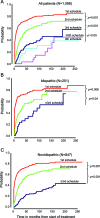Patterns of treatment response in newly diagnosed epilepsy
- PMID: 22573629
- PMCID: PMC3348850
- DOI: 10.1212/WNL.0b013e3182563b19
Patterns of treatment response in newly diagnosed epilepsy
Abstract
Objective: To delineate the temporal patterns of outcome and to determine the probability of seizure freedom with successive antiepileptic drug regimens in newly diagnosed epilepsy.
Methods: Patients in whom epilepsy was diagnosed and the first antiepileptic drug prescribed between July 1, 1982, and April 1, 2006, were followed up until March 31, 2008. Outcomes were categorized into 4 patterns: (A) early and sustained seizure freedom; (B) delayed but sustained seizure freedom; (C) fluctuation between periods of seizure freedom and relapse; and (D) seizure freedom never attained. Probability of seizure freedom with successive drug regimens was compared. Seizure freedom was defined as no seizures for ≥1 year.
Results: A total of 1,098 patients were included (median age 32 years, range 9-93). At the last clinic visit, 749 (68%) patients were seizure-free, 678 (62%) on monotherapy. Outcome pattern A was observed in 408 (37%), pattern B in 246 (22%), pattern C in 172 (16%), and pattern D in 272 (25%) patients. There was a higher probability of seizure freedom in patients receiving 1 compared to 2 drug regimens, and 2 compared to 3 regimens (p < 0.001). The difference was greater among patients with symptomatic or cryptogenic than with idiopathic epilepsy. Less than 2% of patients became seizure-free on subsequent regimens but a few did so on their sixth or seventh regimen.
Conclusions: Most patients with newly diagnosed epilepsy had a constant course which could usually be predicted early. The chance of seizure freedom declined with successive drug regimens, most markedly from the first to the third and among patients with localization-related epilepsies.
Figures


Comment in
-
From patterns to patients: what can we tell people with newly diagnosed epilepsy?Neurology. 2012 May 15;78(20):1542-3. doi: 10.1212/WNL.0b013e3182563c24. Epub 2012 May 9. Neurology. 2012. PMID: 22573642 No abstract available.
References
-
- Callaghan BC, Anand K, Hesdorffer D, Hauser WA, French JA. Likelihood of seizure remission in an adult population with refractory epilepsy. Ann Neurol 2007; 62: 382– 389 . - PubMed
-
- Luciano AL, Shorvon SD. Results of treatment changes in patients with apparently drug-resistant chronic epilepsy. Ann Neurol 2007; 62: 375– 381 . - PubMed
-
- Schiller Y. Seizure relapse and development of drug resistance following long-term remission. Arch Neurol 2009; 66: 1233– 1239 . - PubMed
MeSH terms
Substances
LinkOut - more resources
Full Text Sources
Other Literature Sources
Medical
Miscellaneous
